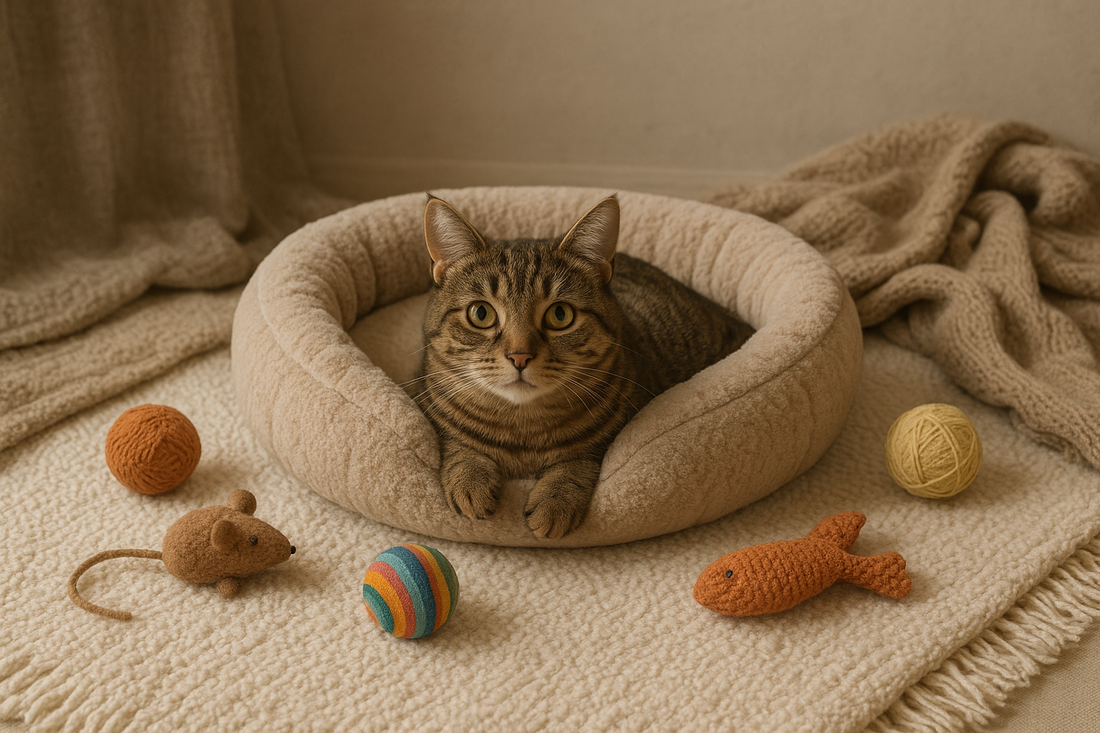
Create a Safe, Enriching Indoor Space for Your Cat
Keeping your cat indoors can protect them from outdoor dangers — like traffic, predators, or harsh weather — but it also means you’ll need to provide plenty of enrichment to keep them happy and healthy. Cats thrive in spaces that let them climb, scratch, hide, and play. With a little planning, you can transform your home into the ultimate cat-friendly haven.
Indoor enrichment isn’t just about comfort — it’s about creating an environment that keeps your cat physically active, mentally stimulated, and emotionally secure. A well-thought-out space can prevent behavioral problems, reduce stress, and strengthen the bond between you and your furry friend.
Whether you live in a cozy studio or a spacious apartment, designing your space with your cat’s instincts in mind can make all the difference. Every perch, hiding spot, and play zone you add turns your home into a feline paradise.
Why Indoor Enrichment Matters
🛡️ Safety First
Indoor cats avoid countless outdoor risks like cars, diseases, extreme temperatures, and encounters with aggressive animals. This safety alone can extend your cat’s life significantly. But staying inside shouldn’t mean boredom — a well-designed space offers both comfort and adventure.
Outdoor cats often face parasites, poisons, and territorial fights. By recreating stimulating experiences indoors, you give your cat the best of both worlds: protection and excitement.
🧠 Mental Stimulation
Cats are natural hunters and problem-solvers. Without opportunities to explore or “hunt,” they can become bored or anxious, which leads to unwanted behaviors — like scratching furniture, over-grooming, or vocalizing excessively.
Providing interactive play and puzzle toys satisfies their curiosity and keeps their minds active. Think of enrichment as their version of mental exercise — it keeps their instincts sharp and their mood balanced.
💪 Physical Health
Indoor cats are less exposed to danger but often move less, which can lead to obesity, diabetes, or arthritis. Encouraging movement through play and climbing prevents these issues. Even short bursts of activity, like chasing a feather wand or climbing a cat tree, strengthen muscles and improve agility.
Regular exercise also supports digestion and reduces stress hormones, helping your cat live longer and happier.
Key Elements of a Cat-Friendly Indoor Space
1. Vertical Territory
 Cats are natural climbers. Vertical space not only offers exercise but also provides comfort, safety, and a sense of control. For multi-cat homes, it even helps reduce territorial tension.
Cats are natural climbers. Vertical space not only offers exercise but also provides comfort, safety, and a sense of control. For multi-cat homes, it even helps reduce territorial tension.
Ideas for vertical enrichment:
- Multi-level cat trees with perches and hideouts
- Wall-mounted “cat highways”
- Window hammocks or suction perches
- Bookshelves or wardrobe tops made accessible with steps
Pro Tip: Place perches near windows or balconies where your cat can safely observe birds, people, or city lights — it’s their version of endless entertainment.
If space is tight, think vertical: floating shelves or wall ladders maximize play zones without cluttering the floor.
2. Scratching Stations
 Scratching is essential for feline well-being. It helps keep claws healthy, stretches muscles, and allows cats to mark their territory through scent glands in their paws.
Scratching is essential for feline well-being. It helps keep claws healthy, stretches muscles, and allows cats to mark their territory through scent glands in their paws.
Provide variety:
- Vertical posts: for full-body stretches
- Horizontal pads: for ground scratching
- Angled boards: a mix of both movements
- Textures: sisal rope, corrugated cardboard, carpet, or wood
Pro Tip: Position scratching posts near favorite nap areas or along paths they walk daily. Reward them when they use the post to reinforce positive behavior.
If your cat prefers your sofa (😼), cover that area temporarily with a scratching mat or double-sided tape while redirecting them to an approved post.
3. Cozy Resting Zones
 Since cats sleep up to 16 hours a day, comfortable resting areas are non-negotiable. They need quiet, warm spots to nap and recharge.
Since cats sleep up to 16 hours a day, comfortable resting areas are non-negotiable. They need quiet, warm spots to nap and recharge.
Rest zone ideas:
- Plush cat beds or self-warming mats
- Soft blankets in sunny corners
- Covered caves or igloos for privacy
- Elevated hammocks for observation
Pro Tip: Create beds at different heights and lighting levels. Some cats enjoy bright, sunny naps; others prefer dark, hidden retreats. Rotate bedding periodically so they can “rediscover” favorite spots.
Adding a worn shirt or blanket that smells like you can also make new spaces more comforting.
4. Interactive Play
 Playtime mimics hunting behavior, offering both physical exercise and emotional satisfaction. Cats enjoy routines, so make play a daily ritual.
Playtime mimics hunting behavior, offering both physical exercise and emotional satisfaction. Cats enjoy routines, so make play a daily ritual.
Engaging play ideas:
- Feather wands for chasing and pouncing
- Toy mice, ribbons, or crinkle balls
- Laser pointers (avoid direct eye contact)
- Puzzle feeders and treat-dispensing balls
- Crinkle tunnels for stealthy ambushes
Pro Tip: Short, frequent sessions (10–15 minutes, twice a day) are ideal. Always let them “win” by catching their toy at the end of play — this prevents frustration.
For extra variety, switch toys weekly or hide them around the apartment so your cat can “discover” them on their own.
5. Window Views & Nature Observation
 Even the smallest apartment can offer a slice of nature. Cats love watching movement — birds fluttering, leaves blowing, or people walking by.
Even the smallest apartment can offer a slice of nature. Cats love watching movement — birds fluttering, leaves blowing, or people walking by.
How to enhance their view:
- Install a secure window perch or sill seat
- Place bird feeders outside windows (safe distance from glass)
- Use sturdy screens and locks for safety
- Add soft bedding or mats to sunny windowsills
Pro Tip: If you live in a city without much wildlife, hang moving mobiles or play looping bird videos — many cats find them mesmerizing!
Sunlight also helps regulate their sleep patterns and keeps their coat healthy.
6. Safe Plants & Greenery
 Nature adds visual and sensory stimulation for your cat — but safety comes first. Many common plants are toxic, so choose wisely.
Nature adds visual and sensory stimulation for your cat — but safety comes first. Many common plants are toxic, so choose wisely.
Cat-safe plants:
- Cat grass (wheatgrass, oat grass)
- Catnip and catmint
- Spider plant
- Areca or bamboo palm
- Boston fern
Avoid: Lilies, poinsettias, philodendrons, aloe vera, ivy, and jade plants.
Pro Tip: Create a dedicated “cat garden” area with edible greenery such as cat grass and catnip. This keeps your cat from nibbling on dangerous plants and gives them something healthy to chew.
Hanging planters can add greenery safely out of reach while keeping your decor stylish.
7. Hiding Spots & Retreats
 Even the most social cats need solitude sometimes. Safe retreats help them self-regulate stress during noise, guests, or household changes.
Even the most social cats need solitude sometimes. Safe retreats help them self-regulate stress during noise, guests, or household changes.
Great hiding options:
- Cardboard boxes lined with blankets
- Cat tents or soft hideaways
- Under-bed or closet corners
- Draped blanket forts
Pro Tip: Always let your cat come out on their own. Never pull them from hiding — it’s their safe space. By respecting that, you build trust.
You can also place calming pheromone diffusers nearby to make hiding zones even more relaxing.
Extra Enrichment & DIY Ideas
Once you’ve built the basics, add more excitement and variety:
1. DIY Toys: Crumpled paper, paper bags, or ping-pong balls make simple entertainment. Just supervise if using a string or ribbon.
2. Food Puzzles: Hide treats in puzzle feeders or cardboard egg cartons to engage their brains and encourage natural foraging.
3. Cat TV: Play nature videos or bird sounds on a loop when you’re away — it’s like background entertainment for felines.
4. Sensory Variety: Introduce new textures, materials, or scents like cat-safe herbs to keep their environment stimulating.
5. Seasonal Adjustments:
⦁ Winter: Heated mats, fleece beds, and sun-access areas.
⦁ Summer: Cooling mats, shaded nooks, and plenty of fresh water.
Pro Tip: Refresh toys and layouts every few months. Cats love novelty and exploration — even moving a bed or adding a new box can spark joy.
Multi-Cat Apartment Harmony
Multiple cats can coexist peacefully with proper planning. The key is resource abundance and vertical space to avoid competition.
Multi-cat essentials:
- One litter box per cat, plus one extra
- Separate food and water stations
- Multiple scratching posts and beds
- Perches at varying heights
- Hiding spots for each cat
Pro Tip: Observe their interactions. Slow blinking, grooming, or resting near each other means comfort; hissing or blocking access signals tension.
Using pheromone diffusers (like Feliway) can help maintain a calm environment. Introduce new cats gradually, allowing scent exchange before face-to-face meetings.
Cleaning & Maintenance Tips
A clean home keeps your cat healthy and your apartment fresh.
- Scoop litter daily and fully change weekly.
- Wash bedding and soft toys regularly.
- Vacuum fur and dander often, especially in corners.
- Wipe surfaces with unscented, pet-safe cleaners.
- Air out rooms to reduce odors and improve air quality.
Pro Tip: Avoid heavily perfumed sprays — cats’ noses are extremely sensitive. A faint natural scent is far more pleasant to them than artificial fragrances.
Environmental Comfort
Your cat’s comfort depends on lighting, sound, and temperature.
- Lighting: Cats love sunbeams but appreciate soft, dim evening lighting. Avoid harsh fluorescents.
- Sound: Keep loud music or appliances to a minimum. Gentle background noise (like a fan or white noise machine) helps them relax.
- Temperature: Most cats prefer warm environments, ideally between 68–78°F (20–25°C). Provide cool mats in summer and cozy blankets in winter.
Pro Tip: Observe where your cat naturally gravitates — that’s the best indicator of their comfort preference.
Common Mistakes to Avoid
❌ Only one scratching post — cats crave variety.
❌ Ignoring vertical territory — climbing reduces tension.
❌ Toxic plants — research before buying greenery.
❌ Over-crowded play zones — leave room for zoomies!
❌ Overstimulation — too much noise or activity can cause anxiety.
❌ Lack of privacy — hiding spots are essential for emotional health.
Final Thoughts
Creating a cat-friendly apartment doesn’t require expensive furniture or a total redesign — just thoughtful touches that support your cat’s instincts.
By offering opportunities to climb, scratch, nap, and play, you build a space where your feline can thrive both physically and emotionally. It’s about transforming your home into a shared sanctuary — one that provides comfort, stimulation, and love.
The result? A cat who’s relaxed, confident, and affectionate — and a pet parent who enjoys a more harmonious, joyful home.
With creativity, patience, and understanding, you can turn even the smallest apartment into a cat’s dreamland. Your indoor cat will live safely, happily, and endlessly entertained by your thoughtful care. 🐱💚
Tags: Indoor Cats, Cat Enrichment, Cat Care, Cat Health, Cat Toys, Cat Furniture
